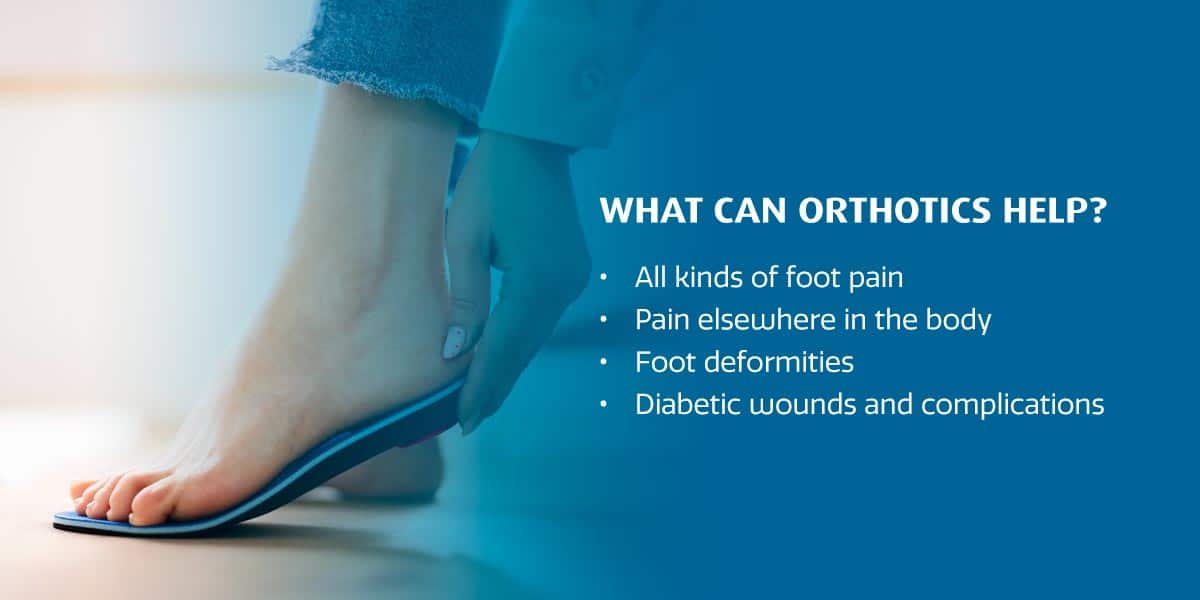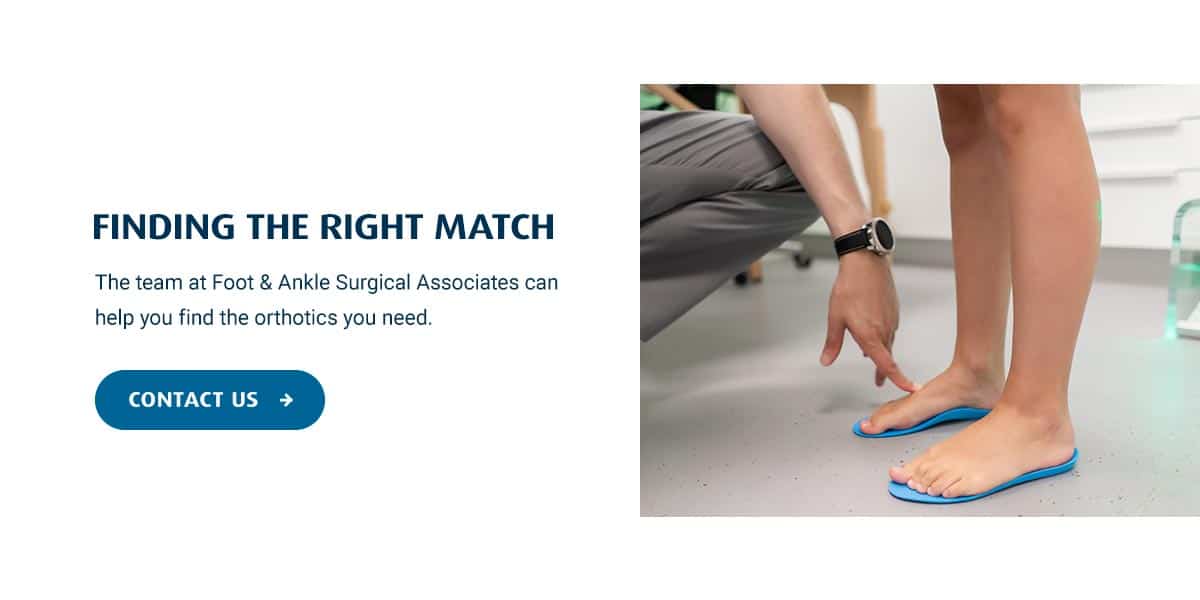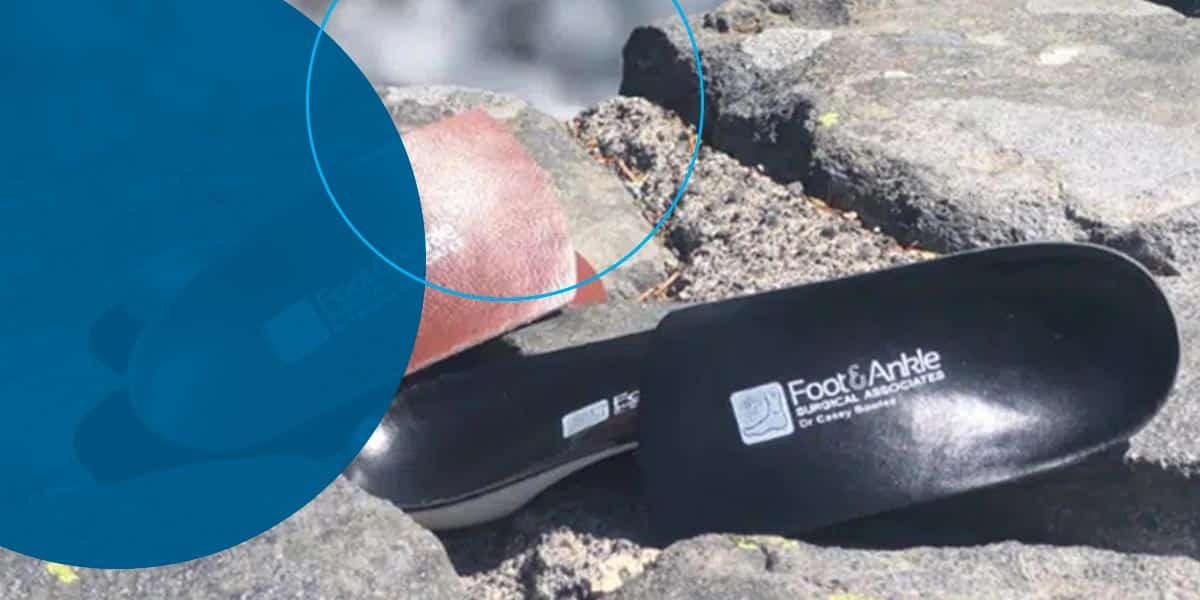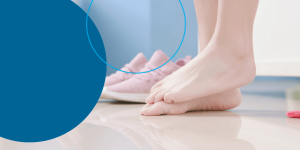No doubt you’ve seen racks of squishy shoe insoles available on pharmacy shelves — some available for ten bucks, others closer to 50 — and wondered what the difference between them was.
You may have even heard conflicting stories from friends and relatives who’ve tried orthotic devices, whether prefabricated or podiatrist-prescribed, with mixed success. Some people swear by them. Others swear at them.
So it’s natural to wonder if the hype is all worth it and whether orthotics could be the solution to your foot pain or fatigue.
Here’s your short and simple answer: yes, orthotics work and can provide significant relief for many common foot and ankle conditions — probably more than you think.
The more complicated answer is that each case is different. Orthotics aren’t going to be the best choice for every individual — and even if orthotics can help you, if you aren’t wearing the correct ones, you won’t reap the benefits!
Keep reading to find out of orthotics are the right solution for your foot and ankle concerns.
Do Orthotics Actually Work?
In short, orthotics actually do work and help with foot pain, foot deformities, diabetic wounds, and potentially pain elsewhere in the body.
Think of your feet as the foundation of a home or the base of a Jenga tower. All your weight is concentrated there, and the rest of your body relies on them to provide adequate support and stability.
Unfortunately, feet aren’t always up to the challenge — at least not as much as we would like. For example, you might have flat feet. Your arches might be too flexible or too inflexible. A metatarsal might be a little longer than ideal. Bones in the hindfoot might be a little out of alignment.
These seemingly minor structural and biomechanical quirks are at the root of many painful foot conditions. And, because bones and joints further up your skeleton may have to realign themselves to compensate for foot misalignments, your feet may even be the root of pain elsewhere. Orthotics are often an efficient way to deal with these problems. Instead of surgery to realign your feet, the orthotics cushion, support or reposition your feet as needed, relieving pain and tension elsewhere.

What Can Orthotics Help?
If structural or biomechanical flaws are at least partially responsible for your pain, there’s a great chance orthotics can be an important part of the solution. Conditions that we have successfully resolved with orthotics include:
- All kinds of foot pain: Heel pain — plantar fasciitis and other diagnoses — is the most common example, but don’t forget about arch pain, forefoot pain, neuromas and more.
- Pain elsewhere in the body: Frequently, persistent knee, hip and even back pain may be at least partially linked to misaligned feet. By realigning your foot biomechanics with orthotics, you might also realign the biomechanics of your entire lower body.
- Foot deformities: Bunions, hammertoes and other structural foot deformities often form — and worsen — due to an underlying structural defect with the feet. Orthotics may help you slow the progression of these deformities or even prevent them to some degree.
- Diabetic wounds and complications: Cushioned orthotics are often a great choice for people with diabetes, with or without diabetic shoes, as your physician recommends. They help protect your feet from damage, especially if you have neuropathy.
How Do Custom Shoe Orthotics Help?
How can orthotics do all these things? And why do some people seem to get no benefit from them?
The short answer is that orthotics — especially if they’re custom-made — exhibit various features, materials, types and purposes. That allows a trained podiatrist to match a specific set of orthotics to the specific needs of a patient.
It also means that simply buying insoles off the rack without guidance may not solve your problem but only discourage you!
One of the first choices podiatrists help you make is whether you need custom orthotics or whether a prefabricated insole will do.
In brief, the advantages of prefabricated insoles are that they’re:
- Inexpensive.
- Don’t require a prescription.
- Immediately available.
Still, because they’re mass-produced and can only approximately fit your foot shape rather than exactly, they may not be as effective or appropriate for more severe biomechanical issues. They also likely won’t last as long, negating some up-front financial savings.
Custom orthotics, by contrast, are unique for every individual, matched to a mold, impression or sometimes even computer scan of your feet. They are a little more costly up-front, and it may take a couple of weeks to get them back from the lab. However, custom orthotics can do much more for your feet than prefabricated insoles.
Types of Shoe Orthotics
We can further break down custom orthotics by their intended function into two broad categories:
- Functional orthotics: Correct and control abnormal motion and help realign your joints so that your walking gait is more normal. They tend to be made from firmer materials — such as plastic, graphite and carbon fiber. Their material makes them ideal for many sports injuries, as well as knee, hip and back pain.
- Accommodative orthotics: Designed for shock absorption, balance and redirecting or relieving pressure away from specific areas. They’re more like the prefabs you can find in the store but better and more optimized. As you can imagine, they’re typically made from soft materials like silicone or cork and are great for people with foot deformities, diabetes or arthritis.
Frequently Asked Questions About Orthotics
Before patients invest in custom orthotics, they often have several questions they want answered to ensure they are making the right decision. Here are some answers to frequently asked questions about orthotics.
How Long Does It Take for Orthotics to Start Working?
Your orthotics may start working within a few days or take a few months to work their magic.
The length of time it takes for orthotics to start working depends on such factors as:
- The quality of your orthotics: The best orthotics are thorough and fast-acting. That is, they work quickly on your feet to correct alignment issues and maintain stability for a long time. In contrast, poor-quality orthotics may provide short-term pain relief before wearing out, take a long time to provide minimal benefits or worsen the condition of your feet. Still, some good-quality orthotics take time to address foot issues but provide high-quality care once your feet get accustomed to them.
- The severity of your condition: If you have significant alignment issues with your feet, it may take more time before you notice significant improvements with orthotics than minor issues.
- The type of condition you’re dealing with: Some conditions require more time than others to address with orthotics.
- How often you wear your orthotics: Like breaking in a saddle or bike seat, the more time you spend using your orthotics, the quicker they will work on your feet. That said, it’s still a good idea to let your feet rest between wears, especially when starting with your orthotics. Aim to wear your orthotics 2-3 times a day for 30 minutes at a time when first breaking them in.
Do Orthotics Feel Uncomfortable at First?
It is common for orthotics to feel uncomfortable at first. Orthotics essentially retrain the muscles in your feet to work in different ways to bring your feet into proper alignment. That said, your orthotics shouldn’t hurt your feet. If you experience pain and significant discomfort with orthotics, speak with your doctor about getting different orthotics or trying a different treatment option for your foot condition.
How Long Will I Need to Wear Orthotics?
The general recommendation with orthotics is to wear them until your pain subsides. You should continue wearing them until you experience sufficient pain relief with orthotics. Still, it’s best to consult with your podiatrist before deciding to go without orthotics. They may recommend that you continue wearing orthotics for a specified time to ensure you receive maximum benefits from them. Your podiatrist can also provide foot strengthening exercises that help your muscles support proper foot alignment.

Finding the Right Match
We’ve said it already a couple of times in this blog, but we’ll say it again — because orthotics can come in so many shapes and styles to treat so many different conditions, it’s important that you have somebody trained to help you make the appropriate selection.
The right set of orthotics — even prefabricated ones, in some cases — can make a world of difference for your feet, legs and back. The wrong ones, at best, will only help slightly. They might even make things feel worse.
The team at Foot & Ankle Surgical Associates can help you find the orthotics you need. We even carry a line of fashionable shoes and sandals with orthotic-like features that may be appropriate for your feet.
With five locations in and around Olympia and Tacoma, we are already in your neighborhood. To schedule an appointment at one of our clinics, please call 360-754-3338 today.



